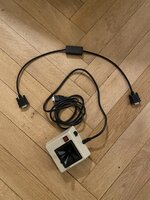Arcade Adapter/Mac Man 1.1
Joystick adapter and arcade game. Pros:
Opens a new market for joystick-compatible soft-
ivarei easy to use: good graphics and speed. Cons:
Game lacks originality and variety\ List price:
$29. Requires: Arcade Adapter, 128K; Mac Man,
512K: joystick. Copy protection: None.
When it comes to speed and graph-
ics, Nuvo Lab.s’ Mac :Man leaves
most Pac Man replicas in the dust.
It doe.sn’t measure up to arcade standards for
color and flashing lights, but it does t^ike full
advantage of the Macintosh's ability to pro-
duce slick animation and imagery.
Grab Your Joystick
This package includes a joystick
adapter that you plug into the Mac s mouse
port. You can attach any Atari-type joystick
to Arcade Adapter; I tried both the Wico
Command Control and Atari Standard
joysticks. Many games benefit from replac-
ing the mou.se with a joystick, and a few;
because of .special design features, un-
dergo a quantum leap in quality. Vov Mac
Man, the stick is e.ssential; the game won’t
run with the mouse, and using the key-
board is hopelessly aw-kw ard.
Arcade Adapter gives the Mac easy ac-
cess to joystick-compatible software (docu-
mentation refers you to the Adapter Inii
File for po.ssible use with other programs).
Nuvo Labs and other companies plan to de-
velop more programs that will w-ork with
the adapter.
Gulp!
Mac Man's mi.ssion is to eat his way-
through a maze of tiny apples while avoid-
ing marauding PC creatures. You control
the mad gulper’s movements through the
maze by maneuvering your joystick in four
directions. You score points for each apple
you devour and earn extra points for di-
gesting various prizes that appear ran-
domly. If you’re caught by an evil PC, it
gobbles you up; how-ever, if you sw'alkm* a
large energy-apple, you can temporarily
turn the tables on your attackers and gain
more points.
Rascals in a Maze
In Mac Man, )'o// travel through a maze, eating
apples and avoiding bad-guy PCs. The Arcade
Adapter bundled with the game lets you control
the action with a joystick.
You can choose to play with up to five
Mac Men for each game. The first few
mazes are quite easy to negotiate. When
you successfully complete a maze, the pro-
gram produces a more advanced one, up to
a limit of 16.
Mac Man's features include comic- re-
lief interludes between mazes, automatic
score keeping, speed and acceleration set-
tings, volume control, four difficulty levels,
and a choice of one or mo players. Sharp,
seamlessly animated graphics depict a
bird’s-eye view of the Mac Man universe
with artful charm (see “Rascals in a
Maze”).
The total effect breathes new life into
a prototype that remains legendary among
video games. PacMan is alive and well on
the Wixc.-Jobn DiPrete
> the only version of Macman still found is version 0.9 beta
> driver disk not found



